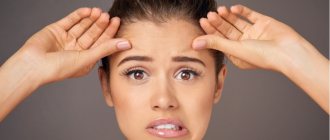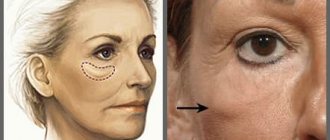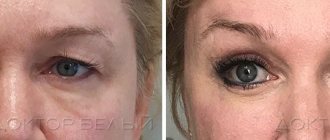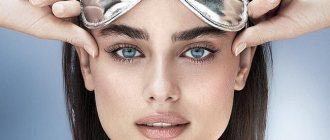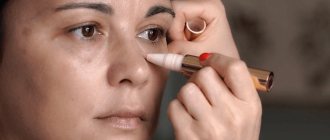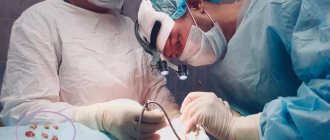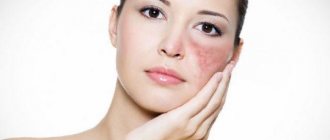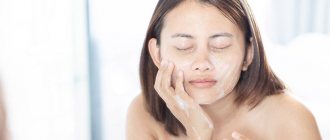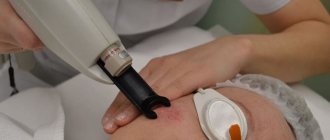| Appointment with a dermatologist at the clinic. Call a dermatologist at home. | Reception is strictly by appointment, make an appointment by phone: +7 | Prices for services | Reviews about the clinic |
Itching and redness around the eyes is an unpleasant sign, disrupting the appearance, which causes a certain amount of discomfort when visiting public places, making it possible to feel your own level of dissatisfaction with the condition of the skin.
The intensity of symptoms may be constant or appear periodically, determining seasonal allergic manifestations or the process of inflammation associated with exposure to an infectious factor. Establishing the cause of the appearance of disturbing signs on the face, affecting the eyelid area, is within the competence of the ophthalmologist, which makes it possible to determine subsequent measures for effective therapeutic recovery.
Make an appointment with a dermatologist by phone or by filling out the online form
| Select a clinic | Skin rash | Dermatologist | Dermatologist at home |
Answers to frequently asked questions about itchy skin:
- Which doctor treats itchy skin?
- What organs are affected by skin itching?
- Why is itchy skin dangerous?
- What tests should be taken for itchy skin?
- What diet is needed for itchy skin?
- What diseases does itchy skin indicate?
- Itchy skin for no apparent reason?
- What parasites cause itchy skin?
- What microorganisms cause itchy skin?
- How to get rid of itchy skin?
- Should a patient with itchy skin be isolated?
- Skin itching due to gastrointestinal diseases?
- What are the main causes of itchy skin?
- How to distinguish allergic itching from parasitic itching?
- How to prepare for an appointment with a dermatologist?
- How to get checked for skin diseases?
- What diseases does a dermatologist treat?
- What tests should be taken by a dermatologist?
- What diagnostics can a dermatologist perform in the clinic?
- Where to go with a skin disease?
Rosacea
Experts are accustomed to using the term rosacea to understand a certain clinical picture: erythema, dilated vessels, and later papulopustular rashes. However, rosacea has several degrees of development and subtypes.
Degree of development of rosacea
- Episodic erythema (rosacea—diathesis);
- I degree - ETR (persistent erythema and single telangiectasia);
- II degree - papulopustular (persistent erythema, numerous telangiectasia, papules, pustules);
- III degree - pustular nodular (persistent erythema, an abundance of telangiectasias, papules, pustules, inflammatory edematous nodes).
There are currently 4 subtypes of rosacea :
- ETR is characterized by persistent erythema of the central area of the face, occurring before or simultaneously with papulopustules (subtype II), telangiectasia, and is accompanied by a burning sensation and tingling sensation.
- PPR - persistent erythema, transient papules and pustules.
- Phymatous rosacea is a thickening of the skin with an increase in the pathologically altered area.
- Ophthalmic rosacea - dryness of the mucous membrane of the eyes, lacrimation, burning, swelling of the eyelids, recurrent inflammation and decreased visual acuity due to damage to the cornea.
Let's move on to diseases that require differential diagnosis with rosacea.
Allergic eye diseases in children
11.01.2021
Due to their anatomical location, eyes are considered the most vulnerable organs to the environment - sunlight, wind and dust. And the organs of vision are open to exposure to a wide variety of allergens that may be present in air masses.
It is worth noting that allergic reactions are three times more common in males than in females. are especially predisposed to developing eye allergies than children living in villages and towns.
Popular allergens and heredity
A factor such as heredity also plays a big role. If the father or mother has an allergy , then the probability of the child developing the same disease is more than 25%, and if both parents, then already 50%.
The list of the most popular allergens includes:
- mold;
- dust;
- pollen;
- dander and animal hair;
- household chemicals;
- down and feathers;
- cosmetics and medicines;
- perfumery.
Eye allergies can also be caused by medications. eye , contact lenses, solutions for their care, and moisturizers to relieve eye may not be suitable .
Causes and types of eye allergies
Allergic eye can also occur from products that contain certain conservative substances and chemical additives.
There are a huge number of varieties of allergic eye , depending on the nature of the manifestation and the location of the lesion.
Allergy symptoms are:
- redness of the eyes ;
- lacrimation;
- swelling of the upper and lower eyelids;
- the appearance of allergic conjunctivitis ;
- seasonal occurrence of conjunctivitis.
There are several types of conjunctivitis:
- hay fever is a predominantly seasonal disease that is caused by pollen during the period of active flowering. The disease is accompanied by frequent sneezing, attacks of suffocation and persistent runny nose ;
- Allergic conjunctivitis can manifest itself both in an acute form and in a protracted form that develops into a chronic one. It can appear due to the consumption of a number of products and from chemical elements contained in household products. Allergic reactions most often occur from 1 year to 7 years. A characteristic sign of this disease are periods of exacerbation in the spring, during the flowering process.
Vernal keratoconjunctivitis lasts for several years and may continue until puberty or stop earlier. Exacerbations alternate with states of remission.
Recommendations for parents for seasonal allergies in children
If your child begins to actively show symptoms of eye allergies, you should:
- try to reduce external exposure. That is, if you are allergic to drops or other medicine, you need to stop using them;
- provide air conditioning;
- It is better to keep the windows in the house or car closed to prevent air containing allergens , if there is a reaction to pollen or flowering;
- When returning from the street, always make sure that the child washes himself, rinses his hands and puts on other clothes in order to cut off contact with allergens .
If the allergy is year-round and does not depend on natural factors, but, for example, is provoked by household chemicals or the presence of animals in the house, you should:
- exclude all contact with animals to which you are allergic ;
- replace household chemicals with hypoallergenic ones to eliminate symptoms;
- Ventilate the child’s room more often so that the concentrated smell of powders and conditioners disappears more quickly;
- It is important for parents to warn their child not to touch or scratch his eyes .
Itching can be relieved with a cold compress.
treat eye diseases on your own . a doctor for help and strictly follow the doctor's .
Published in Allergology Premium Clinic
Seborrheic dermatitis
Seborrheic dermatitis is a chronic inflammatory disease associated with a violation of the amount and composition of sebum and a disturbance of the skin microbiota.
Clinical manifestations : hyperkeratosis, peeling, seborrhea, inflammation and itching.
Localization : areas with the largest number of sebaceous glands, including the T-zone of the face, as well as the scalp, upper third of the back and chest area, ears.
The common feature is centrofascial erythema, the distinctive features are: with rosacea – papules and telangiectasia, with seborrheic dermatitis – the formation of scales and peeling, which are not characteristic of rosacea.
Causes of the symptom
Keep in mind! Redness of the skin around the eyes in an adult or child can be caused by numerous reasons:
- Allergy. Redness may be accompanied by skin rashes and spread throughout the face. The disorder always affects the areas of both eyes.
- Blepharitis. This is an inflammation of the edge of the eyelid with characteristic redness of the skin, mainly in the area of the lower or upper eyelid. It may not extend to the corners of the eyes.
- Eczema. The disease is a chronic or acute skin rash of an inflammatory nature. In such cases, not only the skin, but also the whites of the eyes may turn red.
- Rosacea of the eye. With this disease of the blood vessels of the skin, extensive redness of the periocular area occurs. In this case, accompanying symptoms may appear in the form of pain, photophobia, sensations of the presence of a foreign body in the eyes and uncontrolled lacrimation.
- Lyme disease. A bacterial dermatological lesion leading to rashes and redness around the eyes. Additionally, the patient experiences a feeling of itching and burning. In a complicated form, fever, headaches and dysfunction of the nervous system may develop.
It is worth noting! In addition to these pathological causes, which require drug treatment, redness around the eyes can also occur under the influence of less serious factors.
For example, a symptom may indicate lack of sleep, intolerance to some cosmetics, or injury .
A separate symptom can be considered redness, accompanied by peeling of the skin.
In addition to the fact that this can be observed with allergies, such a sign
may indicate demodicosis - damage to the eyelash follicles by the skin mite demodex.
In this case, this is not the main symptom, and redness with peeling mainly affects the edge of the upper and/or lower eyelid
The spread of redness to the entire periocular space is a consequence of irritation in patients with thin and delicate skin, while the mite itself cannot live on areas of the skin without hair.
Know! In rare cases, peeling and redness are an indirect sign of diseases of the gastrointestinal tract: pathological disorders of intestinal absorption, constipation, dysbiosis, gastritis.
But it is possible to accurately establish the connection between these problems and redness only after examination by a specialist.
Acne vulgaris (acne)
Acne vulgaris usually occurs between the ages of 14 and 25, while rosacea occurs between 30 and 50 years. It is also necessary to carry out a differential diagnosis with late acne .
Common manifestations with late acne
Appearance after 40 years
Papulopustular skin rashes
Overproduction of sebum – oily skin
Possibly - prolonged exposure to the sun - a common “trigger”
Differential diagnosis
Criteria not typical for acne are diagnostic for rosacea:
Centrofascial erythema is redness of the central part of the face, which may be accompanied by subjective sensations of itching, burning or tingling. A must-have for rosacea!
Outbreaks of erythema - occur when nerve endings are irritated by provoking factors: stress, heat exposure, drinking hot and alcoholic drinks, etc.
Couperosis – appearance on the face, because the disease affects the vascular bed.
No comedones!
Anamnesis
An important part of any consultation. If the rash was present at a young age, the development of late acne is most likely.
Prevention
As a rule, treatment is not required when adequate disease prevention has been established. To prevent red spots from appearing in the eye area, it is necessary to act comprehensively: make it a rule to lead a healthy lifestyle, organize yourself proper rest, as well as sleep.
It is also necessary to strengthen the body’s immune system, for which it is worth taking the necessary vitamins and minerals. Reduce mental and visual stress, walk more often. Which will lead to the disappearance of symptoms and red spots will no longer be a serious problem for you.
Perioral dermatitis
Synonyms: rosacea-like dermatitis, flight attendant disease - rashes around the mouth: redness, swelling and papules.
Diagnostically difficult to distinguish disease of unknown etiology. Provoking factors : the use of steroids both locally and inhaled, fluoride-containing pastes, occlusive cosmetics.
The main diagnostic differences from rosacea: bright erythema and telangiectasia are rare. Localization: nasolabial folds, perioral region, chin, lower eyelids. Women aged 20-30 years and children are affected.
Distinctive feature : rapid regression of rashes, if a trigger factor is identified.
If visual diagnosis is difficult, a histological examination is recommended.
Diagnosis and treatment of SLE at the Yauza Clinical Hospital
Diagnosis of systemic lupus erythematosus at the initial stage of development makes it possible to achieve rapid and stable remission of the disease and avoid the development of severe complications. In the treatment of lupus, we use drug therapy (steroidal and non-steroidal drugs, biological genetically engineered drugs), methods of extracorporeal hemocorrection.
If symptoms of SLE appear, contact rheumatologists at the Yauza Clinical Hospital. Modern treatment methods, subject to preventive measures, make it possible to maintain a state of remission for years and even decades, give birth to children, and lead an ordinary normal life.
You can see prices for services
